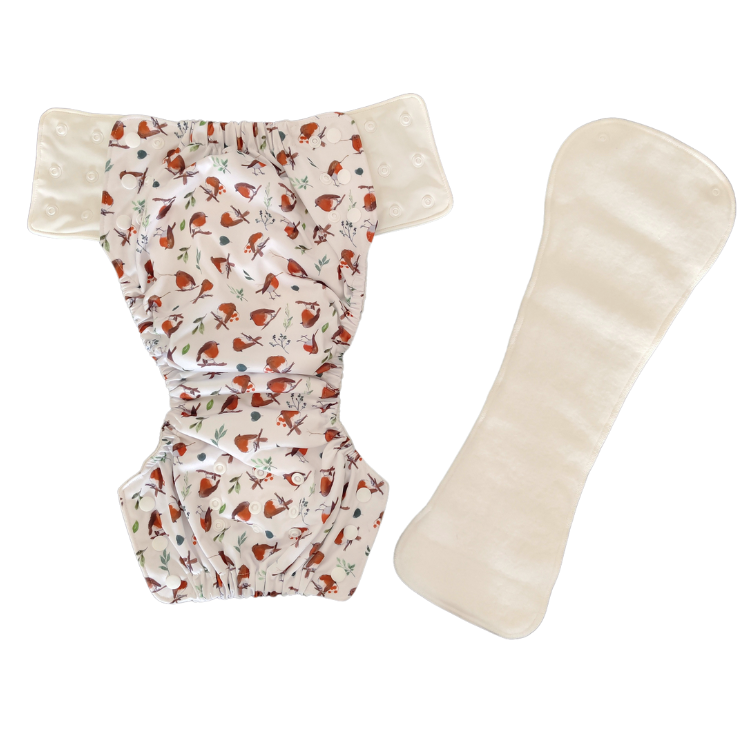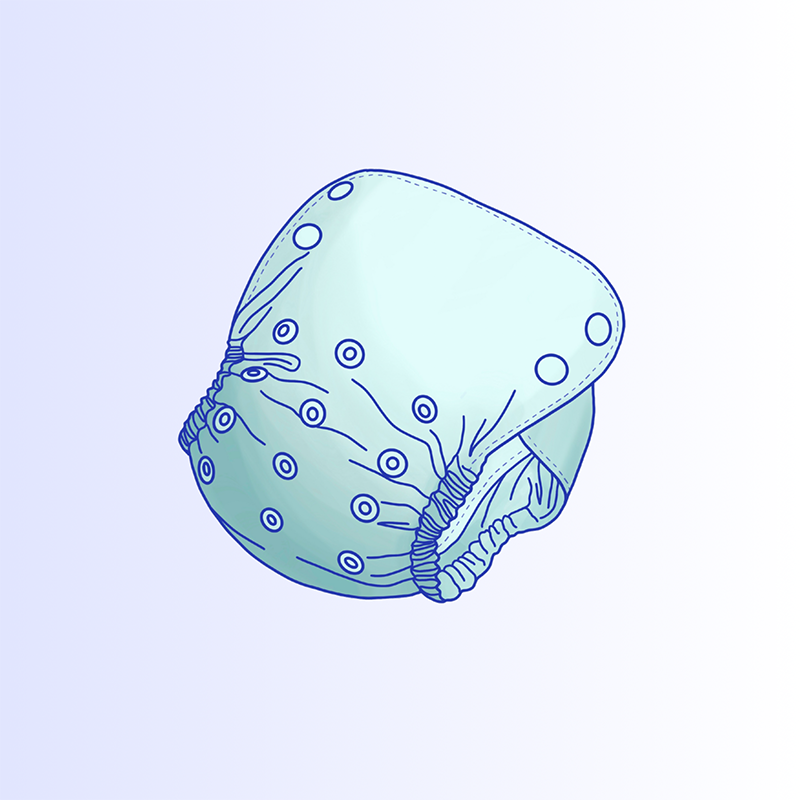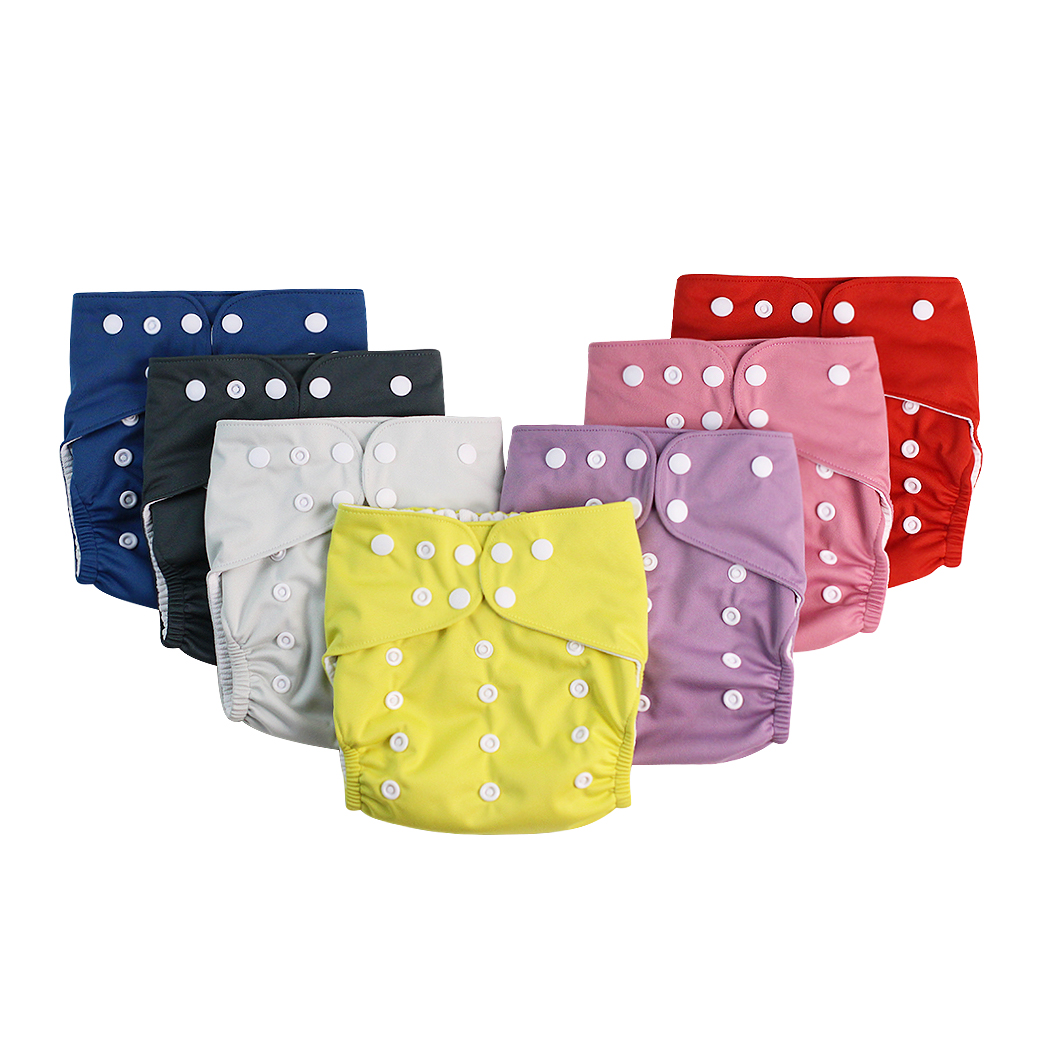- All
- Product Name
- Product Keyword
- Product Model
- Product Summary
- Product Description
- Multi Field Search
English
Reusable diapers are gaining popularity for their environmental benefits, cost-effectiveness, and comfort for babies. But how do reusable diapers work, and what makes them an attractive choice for parents? In this post, we’ll explore everything you need to know about reusable diapers, from their components and different types to how they work and their maintenance.

Reusable diapers consist of several key components that work together to keep your baby dry and comfortable. Let's take a closer look at each part.
The absorbent layer is crucial for retaining moisture. It is made from materials like cotton, bamboo, or microfiber. Each material has different absorbency levels, but they all serve the same purpose: to absorb and distribute moisture efficiently. Microfiber, for example, absorbs quickly, while bamboo is gentle on the skin and highly absorbent. This layer is essential in keeping your baby dry between changes.
The waterproof layer prevents leaks by keeping moisture contained within the diaper. Common materials for this layer include PUL (polyurethane laminate) and lanolised wool. PUL is a breathable, waterproof fabric that allows air circulation while preventing liquid from escaping. This ensures your baby stays comfortable without feeling wet, while also reducing the risk of diaper rash.
Reusable diapers use different types of fasteners to secure the diaper. These can be Velcro, snaps, or ties. The fasteners allow for a customizable and adjustable fit. Velcro and snaps are popular for their convenience and ability to keep the diaper securely in place, preventing leaks and ensuring the diaper stays snug throughout the day or night.
Optional liners can be used for added convenience. These can be disposable or reusable, depending on your preference. Liners make cleanup easier by catching solid waste and can be replaced after each change. Reusable liners are often made from fleece or other soft materials and can be washed along with the diaper. They help reduce the mess and make diaper changes quicker and more efficient.

Reusable diapers are designed to be as effective as disposable ones, with the added benefits of being eco-friendly and cost-saving. Let’s dive into how these diapers work and how to use them properly.
Changing a reusable diaper follows a similar routine to disposable ones, but there are a few key steps to ensure cleanliness and effectiveness.
Remove the Diaper: Start by taking off the soiled diaper. If you're using a pocket diaper, remove the absorbent inserts.
Clean the Baby: Gently clean your baby with wipes or a damp cloth, just like you would with a disposable diaper.
Replace the Diaper: Place a clean, absorbent insert inside the diaper and secure it on the baby with snaps, Velcro, or ties. Be sure the diaper fits snugly to prevent leaks. The process is similar to disposable diapers, but the big difference is that the diaper is reusable, and the inserts can be replaced.
Reusable diapers require more maintenance than disposables, but they are also more sustainable. Here’s how to clean and care for them:
Rinsing: After removing the solid waste (which you can dispose of in the toilet), rinse the diaper to remove excess urine.
Washing: Wash the diapers in a machine with hot water, using a cloth-safe detergent. It’s important to wash the diapers separately from other laundry to avoid contamination.
Drying: Air dry your diapers or use a dryer on a low heat setting. Drying helps prevent odors and maintain the material’s integrity. To store soiled diapers, keep them in a wet bag or pail until wash day. Don’t leave them for too long to avoid odor buildup.
Drying is a critical step in maintaining the diaper’s effectiveness and lifespan.
Air Drying vs. Dryer: While air drying is gentler on the material, using a dryer on low heat can be more convenient. Be sure to dry the diapers thoroughly to prevent moisture buildup.
Reusing: After drying, the diapers are ready to be reused. To maximize the lifespan of your diapers, avoid frequent hot drying and instead opt for air drying when possible.
Waterproof Layer Care: Be gentle with the waterproof layer (e.g., PUL) to maintain its effectiveness. Excessive heat can damage the material and reduce its waterproofing abilities. With regular cleaning, drying, and proper care, your reusable diapers will last a long time, providing comfort and environmental benefits for your baby.

Reusable diapers come in a variety of styles, each offering unique features for different needs. Let's break down the most common types of reusable diapers.
What are AIOs and how do they work?
All-in-One diapers (AIOs) are the simplest type of reusable diaper. They consist of a waterproof outer layer and absorbent layers sewn together, making them very easy to use. You simply place the diaper on your baby, fasten it, and you’re done.Pros and cons of AIO diapers
Pros: Easy to use, no need to assemble or insert anything, ideal for daycare or caregivers.
Cons: Take longer to dry due to the absorbent layers being sewn in, not as customizable for absorbency.
Explanation of pocket diapers and their flexibility
Pocket diapers feature a waterproof outer layer with an inner pocket where you can insert absorbent pads or liners. This design offers flexibility since you can adjust the absorbency based on your baby’s needs.
Customizing absorbency with pocket diapers
You can add more inserts for extra absorbency or use thinner ones for daytime use. This allows parents to personalize the diaper’s performance.
Pros and cons of pocket diapers
Pros: Customizable absorbency, quicker drying time since the inserts are removable.
Cons: Requires stuffing and unstuffing, which can be time-consuming. Some parents find them bulkier.
How to insert and remove absorbent pads in pocket diapers
To use pocket diapers, simply insert the absorbent pad into the pocket, ensuring it’s positioned correctly. After use, remove the insert for washing.
Description of prefold diapers and their folding techniques
Prefold diapers are rectangular pieces of fabric that are thicker in the center, typically made from cotton, bamboo, or hemp. They require folding before use, either by pad folding or using a special folding technique.
Benefits of using prefolds and waterproof covers
Prefolds are affordable, easy to clean, and versatile. You can adjust the absorbency by adding more layers or using different materials. They require a waterproof cover to prevent leaks.
Challenges with prefold diapers
Requires practice to fold them properly.
Need a separate waterproof cover, making the diapering system a bit more involved.
How fitted diapers work and their absorbency
Fitted diapers are shaped like a disposable diaper and include elastic around the legs and waist. They have a high absorbency rate, making them great for heavy wetters and nighttime use.
Why fitted diapers are ideal for overnight use
The absorbent layers in fitted diapers are often thicker, providing long-lasting protection that helps your baby stay dry throughout the night. Pair them with a waterproof cover for the best results.
How AI2s differ from other types
AI2s consist of a waterproof cover and a separate absorbent insert. The insert is snapped or laid inside the cover, making it easy to change only the absorbent part, while the cover can be reused.
Benefits of AI2s for customizable absorbency and easy drying
AI2s offer flexibility since you can use different inserts depending on your baby’s needs. They also dry faster than AIOs, as only the insert needs to be washed.Cost-efficiency of AI2 systems compared to AIOs
AI2s tend to be more cost-effective than AIOs because you don’t have to replace the whole diaper after each use—just the insert. This makes them a great option for budget-conscious parents.
Cloth diapers have come a long way since their traditional counterparts. Today’s modern cloth diapers offer improved functionality, ease of use, and greater environmental benefits.
No Folding or Safety Pins Required
Unlike traditional cloth diapers, which needed folding and safety pins, modern cloth diapers are designed for convenience. They come pre-shaped, with adjustable fasteners like Velcro or snaps, making them easy to put on and remove.
Materials Used for Ease of Use
Modern cloth diapers use advanced materials like PUL (polyurethane laminate) for waterproofing and microfiber or bamboo for absorbency. These materials make diapers more effective at preventing leaks while still being soft and comfortable for babies.
Advances in Design and Absorbency
Today's cloth diapers feature innovative designs, such as stay-dry layers, which help keep moisture away from the baby’s skin. Additionally, adjustable fasteners and snap systems allow for a custom fit, making modern diapers more adaptable to growing babies.
Reduced Waste and Chemical Use Compared to Disposables
Traditional cloth diapers, like disposables, also contributed to landfill waste. However, modern cloth diapers reduce waste significantly because they can be washed and reused multiple times. Unlike disposable diapers, they don’t rely on chemicals like bleach and perfumes, making them a healthier choice for both your baby and the environment.
Sustainability of Modern Cloth Diaper Systems and Their Lifespan
Modern cloth diaper systems are designed to be durable and long-lasting. With proper care, many diapers can be reused for several years or passed down to other families. This extended lifespan makes them a more sustainable choice compared to disposable diapers, which are single-use only.
While reusable diapers offer many benefits, they do come with their own set of challenges. Here’s what you need to know before making the switch.
Washing, Drying, and Storing Diapers
Reusable diapers require regular washing, which can take time and effort. After each use, diapers need to be rinsed, washed, and dried. Storing dirty diapers until laundry day also requires planning, as you’ll need a wet bag or pail to keep them contained.
Learning Curve for New Users
If you're new to cloth diapering, there’s a learning curve. Understanding how to properly fit the diaper, adjust absorbency, and manage laundry can take some time. But with practice, it becomes a routine.
Tips for Making the Cleaning Process Easier
Use diaper sprayers to rinse soiled diapers quickly and prevent stains. Liners can also be a game changer—disposable or reusable liners catch solid waste, making cleanup much easier. Consider having a set of liners on hand to simplify changes.
Tips for Ensuring a Proper Fit
Ensuring a proper fit is key to avoiding leaks. Adjust the snaps or Velcro to ensure the diaper sits snugly around your baby’s waist and legs. The diaper should feel snug but not too tight.
How to Prevent Leaks with the Right Diaper System and Absorbency
Choose the right diaper for your baby’s needs. Heavy wetters may need diapers with higher absorbency, like fitted diapers or those with extra inserts. Don’t hesitate to customize the absorbency by adding more layers.
Troubleshooting Leaks and Ensuring Diaper Longevity
If leaks occur, check the fit and absorbency. Sometimes leaks happen if the diaper is too loose or too tight, or if it needs an extra insert. Over time, replace worn-out elastic or waterproof layers to maintain the diaper's effectiveness.
How to Manage Soiled Diapers on the Go
When you're out and about, soiled diapers need to be dealt with quickly. Carry a wet bag to store dirty diapers until you can wash them. These bags are designed to be waterproof, keeping odors contained.
Using Wet Bags and Keeping Diapers Clean While Traveling
Wet bags are perfect for storing dirty diapers while traveling. Pack a few extra wet bags for long outings to make sure you always have a clean one on hand.
Disposing of Solid Waste in Public Spaces
If you need to dispose of solid waste in a public restroom, use a diaper sprayer to rinse the diaper or use a disposable liner to catch waste. Some parents prefer carrying a small portable spray bottle or wipes for easier cleanup on the go.
Reusable diapers offer environmental, health, and financial benefits. They reduce waste, promote better skin health, and save money in the long run. If you're looking for a sustainable, cost-effective solution, reusable diapers might be right for your family.
A: Generally, reusable diapers need to be changed every 2-4 hours, depending on the baby’s wetting frequency.
A: Reusable diapers are generally made from breathable materials, which can help prevent diaper rash if properly maintained and changed frequently.
A: Yes, while the initial investment is higher, reusable diapers can save money over time due to their durability and reusability.
A: Yes, some types like fitted diapers or All-in-Ones (AIOs) are designed to handle overnight use by offering extra absorbency.
A: Yes, reusable diapers reduce waste and chemical exposure compared to disposable diapers, making them a more sustainable option.